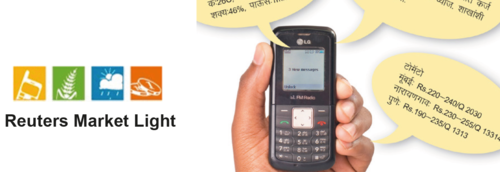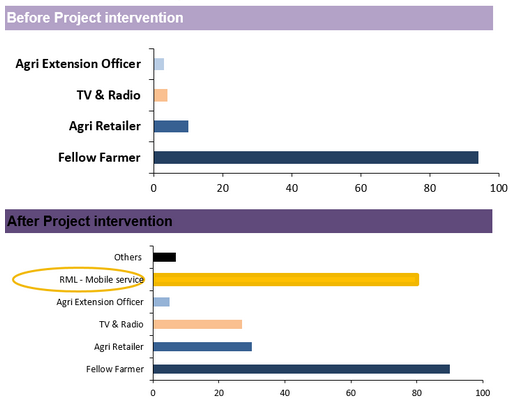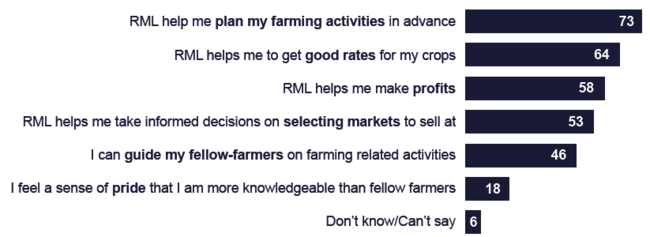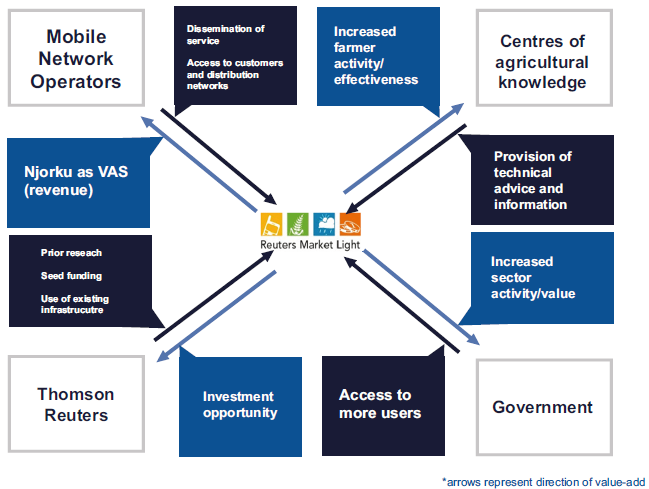Reuters Market Light Information Services (RML) is a unique mobile-based provider of technical and financial advice to farmers in India. Initially operating under the international media organisation Thomson Reuters, the service works with content partners to provide personalised information on farming techniques, crop recommendations, weather forecasts, and various other pieces of agricultural information across 17 states in 9 different languages. It also features Krishidoot, a component that acts as a platform for farmers, enterprises and agricultural stakeholders to interact and transact. Through Krishidoot, these parties can buy and sell agricultural produce and supplies at published prices without operating through middlemen and agents. Through these methods, RML contributes to increases in productivity and financial security for farmers across India.
Year Launched: 2007
Business Model: Consumer
Targeted Device: Basic Phone
Primary Delivery Technology: SMS
Products & Services: Interactive Content
Markets Deployed In: India
Estimated Total Number of Users: 1.3 Million
Background and opportunity:
The idea behind RML originated in 2006 after detailed research and market surveys carried out by Thomson Reuters proved the need for an agricultural information service for farmers in India. The result of the research revealed that farmers across India were suffering as a result of the inaccessibility and asymmetry of market information. Farmers tend to work with local traders and middlemen to act as distributors of their produce, who often offer less favourable rates than the market would otherwise dictate, in order to earn extra commission for themselves. Given the involvement of so many middlemen along the supply chain, farmers had no way of knowing the actual value of their crops. This meant that they were often undercharging for their produce and suffering financially as a result. In the developed world, farmers tend to receive 40-50% of their produce’s final value. However, this situation resulted in Indian farmers receiving only 20-25%.
There was a clear gap in the market for a service that could overcome this problem. It was with this in mind that RML was conceived as a way to provide Indian farmers with agricultural information that was unbiased, actionable, accurate, and timely. Mobile is among the most accessible and widely-used forms of media in rural India, and also allows for more customisation of information and delivery style than other channels such as radio or television. For these reasons, it was decided that the service would be most effective if delivered through mobile.
Objective:
The overarching objective of RML is to become the preeminent platform for the engagement and interaction of farmers and agricultural communities. Through this, they ensure access to relevant information and the ability to transact with one another directly, thereby providing maximum efficiency and value for farmers buying and selling farm produce and related products.
Results:
- RML has 1.3 million registered unique users. Independent research shows that users tend to share information with another 5-6 farmers over the course of year. This suggests that between 6 and 8 million farmers have already been impacted by the service.
- The income of farmers using the service has increased by 15-25%.
- Younger farmers selling directly to traders are able to increase their price realisation by 9% as a result of using the RML service.
Impact:
As a result of customised advice, based on market and technical information from a number of reliable sources, combined with a platform through which to buy and sell at market prices, farmers’ productivity and cost-efficiency is greatly increased.
Lessons Learned:
- Keep your ear to the ground – These services should be based on users’ needs, and should be designed and updated accordingly – you cannot simply roll something out and expect it to stand up on its own. RML recognises that their perspectives from 3-5 years ago are unlikely to remain relevant in the future. The service is therefore continually improved and new features regularly added.
- Focus on content before acquiring customers – Services operating in the same market as RML have fallen foul of this. It is vital to build a strong foundation of useful, meaningful and actionable content before turning your focus to marketing and customer acquisition.
- Create a vibrant ecosystem of partners – There is value in having a number of reliable partners operating across different functions such as content creation, distribution, and finance in order to keep your service efficient and effective.
- Dependence on donor funding can only take you so far – Reliance solely on donor funding runs the risk of preventing the service from becoming self-sustaining. Instead, it is advisable to adopt a self-sustaining business model as soon as possible – if not right from the start.
Figure1: Farmers’ preferred sources of information
Approach:
The development of the RML service has been continuously informed by market research, customer surveys, and pilots. From the beginning, it was designed to be simple, easily accessible, and able to fit into a farmer’s daily routine. The team avoided overloading farmers with information that was irrelevant or too generalised. This eventually led to the formation of the basic SMS service that provides individual farmers with personalised information about the market prices of the crops they grow, as well as weather information according to location, and tailored professional advice. The service is very easy to activate, requiring a farmer simply to buy a prepaid card and call their local RML representative. RML’s income is generated through paid subscriptions from farmers and through sponsorship.
This initial iteration of the service has since evolved in response to further market research and customer feedback. RML responded to increased smartphone penetration in India by creating an app that could provide similar value. Furthermore, accurate market knowledge does not solve the problem of finding interested buyers. In order to address this, RML created Krishidoot, its market linkages service. Here a farmer can advertise what they want to sell or buy and link with any enterprises who wished to transact with them. RML sees the development of this service as an on-going process, and intend to evolve accordingly in the future.
User Centric Attitudes:
As the evolution of RML’s approach demonstrates, the service’s design is very customer-centric. In addition to the market research carried out prior to the establishment of the service, on-going customer feedback guides its development. RML has a team dedicated to acquiring customer feedback, and customers are provided with an easy first port of call in the form of RML’s call centres. Such open dialogue has contributed to past additions and alterations to the service, namely the discussed establishment of the Krishidoot platform.
Figure2: Reasons for buying RML subscription
The Use and Value of Data:
RML regularly uses data to refine and improve the service. Large amounts of data are generated organically such as user location, language, crops grown (and variety thereof), type of fertiliser used, irrigation system (if any), sowing dates, and a number of other indicators. One primary use of this data is that it allows RML to build profiles for individual farmers. This enables RML to ensure that the advisory information they provide is consistently relevant and specific to particular locations, dates, and land types.
The information collected is also studied by the data analytics team in order to maximise the user experience, develop new features, and solve any issues that may have arisen. This has resulted in a number of valuable insights on various elements of the operation. For example, when trying to find ways to improve customer retention, RML discovered that retention levels in some geographical pockets were 3 times as high as elsewhere. As a result, RML could effectively identify drivers of success in those areas and subsequently replicate them elsewhere. In addition, RML could determine which areas were deserving of more focus.
There is an appreciation across RML of the value of data analytics as a provider of insights into what customers and the market need. However, despite having an existing data analytics programme, this is an area in which RML sees more potential. Indeed, in order for the service to grow, RML must navigate a landscape consisting of known unknowns (areas which RML has identified but is yet to properly explore) and unknown unknowns (various undefined gaps with which RML is not yet familiar). The latter will only be discovered and filled once RML becomes more mature in its data analytics.
Success and Scalability:
In measuring the success of the service, RML concentrates primarily on the raw figures of how many farmers are being reached. Rates of adoption act as strong indicators of the value that farmers are extracting from the service. There are approximately 1.3 million unique registered users of the service. RML aims to reach 30 million farmers in the near future both directly and indirectly. With regards to Krishidoot, performance of the service is measured against the wider objective of transforming it into the preeminent and most accessible platform of its kind across India. Currently the service is active in 17 of the 28 Indian states and can also be accessed online. In addition to these, various other metrics are being developed that will be more relevant for RML’s growing array of services. These will be focused on visible on-the-ground impact on farmers and other stakeholders in agricultural value chains.
Despite these ambitions, however, there some ways in which RML’s current capacity limits it from doing everything that it would like to do. The most significant of these is the ability to increase awareness of the service and driving registrations thereafter. RML currently sees this as the most pressing bottleneck with regards to adoption. One way in which this is currently being tackled is by giving potential users access to trial versions in order to help more farmers find out about what the service is without having to pay beforehand – the hope being that this will enable them to see the value of the service and subsequently adopt it for themselves. This remains an area that could benefit from increased access to the rural population and the capacity to further drive registrations through marketing and an expanded trialling process.
Partnerships
A number of key partnerships have helped RML to grow and sustain its service since its initial launch.
The first of these may not be considered a partnership in the traditional sense: RML’s relationship with Thomson Reuters. The project was initially born out of Thomson Reuters’ pre-existing operations in India, and was incubated there in its earlier years. For RML, this brought stability, funding and an infrastructure. In 2013, RML was hived off as an independent, private equity funded, entity in order to establish an optimum governance structure for the rapid growth of an entrepreneurial venture. Thomson Reuters remains a minority stakeholder in the project.
RML partners with a number of organisations who act as content providers for their agricultural and market information. These partners include centres of agricultural knowledge such as universities and the Indian government’s Ministry of Agriculture. Such partnerships are integral to the running of RML, as they provide the foundation of content on which the programme is based. Through these partnerships, RML is provided with specialised technical information to relay to farmers. RML also benefits from these organisations’ wider reach across rural India.
The project also partners with the public sector in order to increase the accessibility of the service. The Indian Government’s Ministry of Agriculture and other public sector agencies (along with some private sector groups) sponsor RML to provide the service free of charge to farmers in certain targeted areas. This brings two main advantages – first, small and marginalised farmers who may not be able to afford the service are able to reap the benefits. And second, temporary subsidised usage of the service can be used to educate farmers on RML’s benefits, in the hope that they will see it as a valuable investment to later pay for themselves. This partnership represents a recognition by these parties of the positive impact brought to Indian farmers, and the nation as a whole, by RML.
Finally, RML has partnered with a small number of MNOs in the past. These have never taken the form of exclusive partnerships, instead acting more as temporary measures for increasing the reach of the RML service. These have operated on a number of different models. For example, RML worked with one MNO to further spread their provision of agricultural information by distributing prepaid scratch cards through the partner’s distribution network. Additionally, RML has experimented with positioning themselves as a value-added service on a network; this brings further reach to RML, and the possibility of increased access to more customers for the MNO involved.
While partnerships have their benefits, a misalignment of objectives can result in them becoming counterproductive and short-lived. For example, MNOs naturally have their own objectives and priorities, of which the delivery of agricultural information to farmers does not tend to be a primary one. Rather, this is seen more as a means to the end goal of acquiring more customers. As a result, the two parties’ areas of focus can differ, leading to an inefficient working relationship. However, as the mobile landscape in India changes, MNOs’ focus is perceived to be moving away from aggressive customer acquisition, and increasingly focusing on the services accessed by customers. This means that, in the future, MNO partners are likely to recognise the importance of agricultural information and similar services. RML is therefore becoming more encouraged by the possibility of specific partnerships with MNOs.
RML does have criteria in place for identifying potential partners. Firstly, it has learned that it should only partner with organisations who have a strong reach and presence in rural areas. In doing so, it can ensure that all partnerships contribute in some way towards an overarching objective of increasing penetration of less accessible rural markets. Secondly, it has learned that the involved parties’ objectives must be deeply aligned and/or interlinked in order to maintain the direction of the relationship. As discussed in the context of partnerships with MNOs, misalignment here can lead to unproductive and dysfunctional relationships. Should these criteria be met, RML is open to any partnerships which can bring value to its service.
Figure 3: Partnership Map for Reuters Market Light
Challenges:
RML’s biggest challenge has been around farmers’ willingness to try and adopt the service. Across India, many farmers work in a traditional way that has been unchanged for generations. The geographical spread of the Indian rural population reinforces this farming methodology, as new methods and technology are less able to spread across rural and hard to reach areas. As a result RML has faced difficulties in driving the widespread adoption by farmers across the country.
Attempts to overcome this challenge can be broken down into three components: awareness, accessibility, and attractiveness. First, RML must raise awareness of its service. This is achieved through a process of on-going in the form of free trials. Second, it must ensure that the service is accessible for farmers across India. Attempts to do this have entailed the utilisation of the rural presence of partners such as the Ministry of Agriculture. Finally, the service must be made attractive to those farmers whose traditional methods make them reluctant to adopt it. RML sees continued improvement of an accurate and personalised service as the best way to achieve traction in this respect.
Linked to the challenge of gaining farmers’ acceptance of RML is the challenge of attempting to expand in a country with such diversity in language, culture, land, climate and other regional variables. RML has to continually consider the appropriateness of its model, content and delivery methods as they expand across different parts of the country. Since its inception, RML has directly reached 1.3 million farmers in 17 states. However, there are an estimated 120 million cultivators across the country’s 28 states. This demonstrates that the service’s reach, whilst significant, is by no means maximised. Looking forward, RML seeks to overcome this challenge by developing new delivery methods in order to continue to acquire more users across India’s sporadic rural populations.
Future Plans:
There are two dimensions to RML’s future plans. Firstly, it will move into new service delivery methods, moving away from being entirely SMS-based to offering apps and WAP versions of the agricultural information service. Going forward, RML will continue to explore its viability as a value-added service through partnerships with MNOs.
Secondly, RML is planning to move into new products which complement and enhance the agricultural information service. Indeed, this process has already begun with Krishidoot, providing a platform for engagement and enabling transactions among farmers and agricultural stakeholders. Nothing is yet set in stone, but RML plans to continue moving in this direction with the aim of engaging more users and increasing in the number and variety of services which they can offer.
Each of these dimensions are based on the idea that reaching more farmers across India will enable them to achieve increased productivity and financial well-being. These will assist RML in moving towards its goal of becoming the preeminent platform for the engagement and interaction of all agricultural players across India.
This document was originally produced as part of the former Mobile for Development Impact programme.






